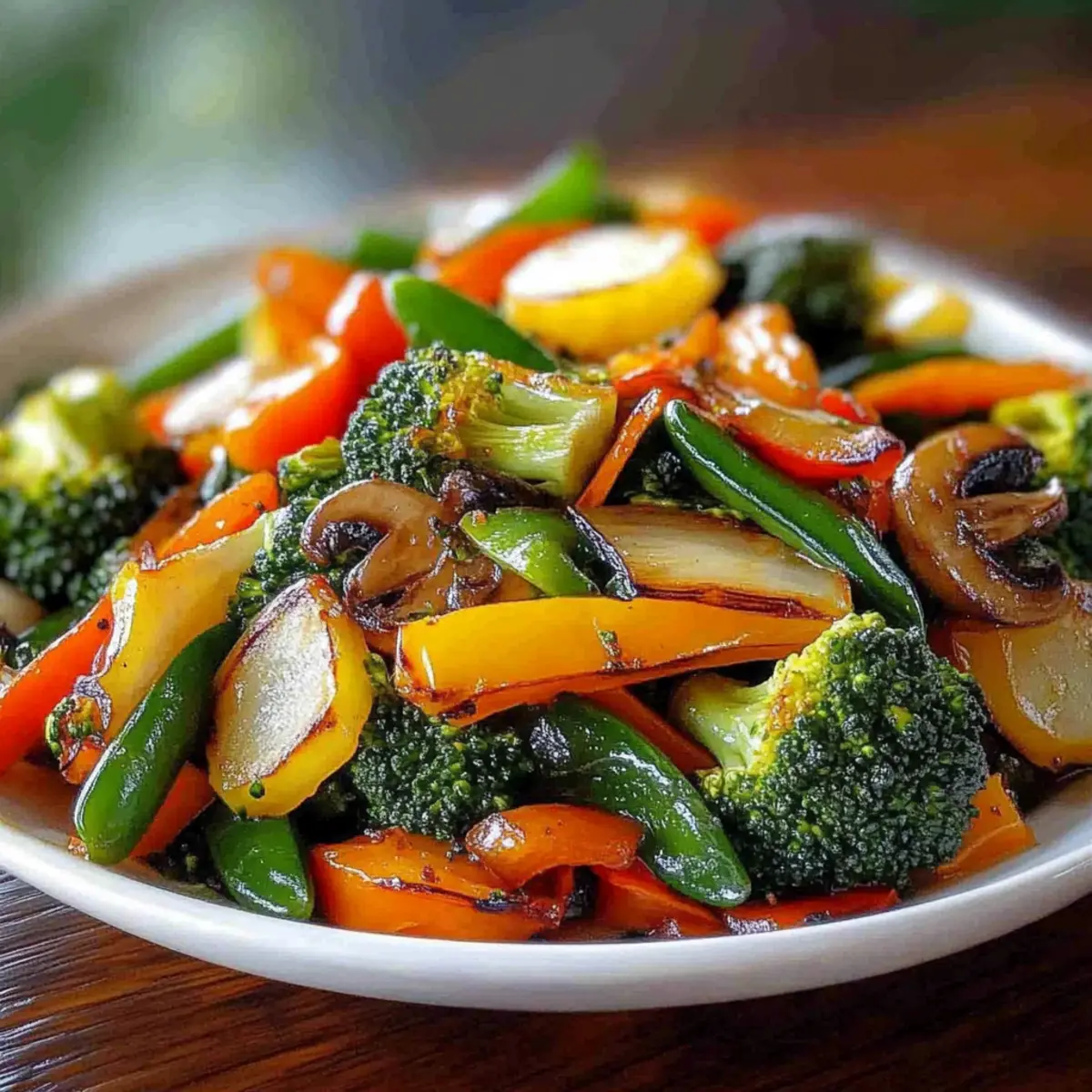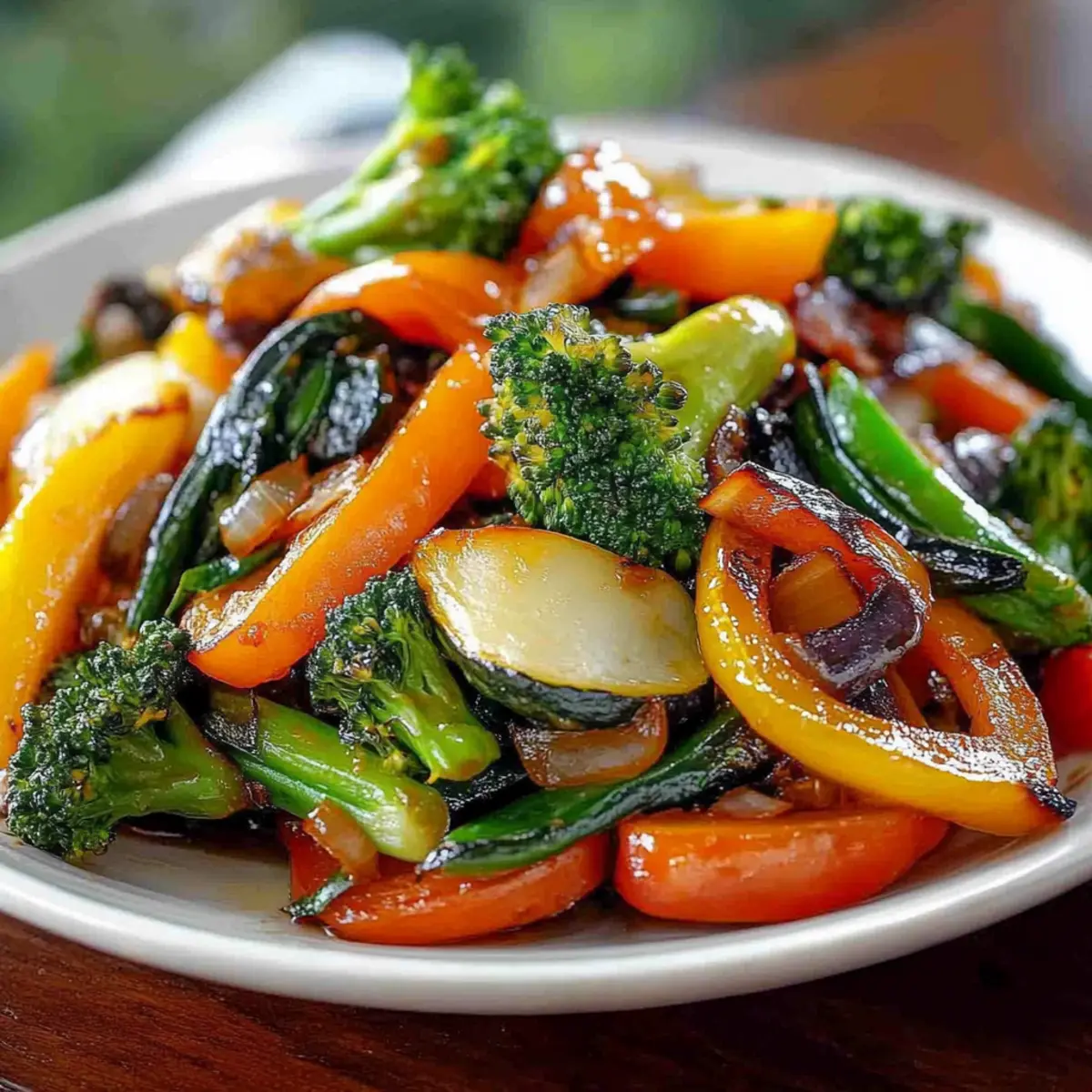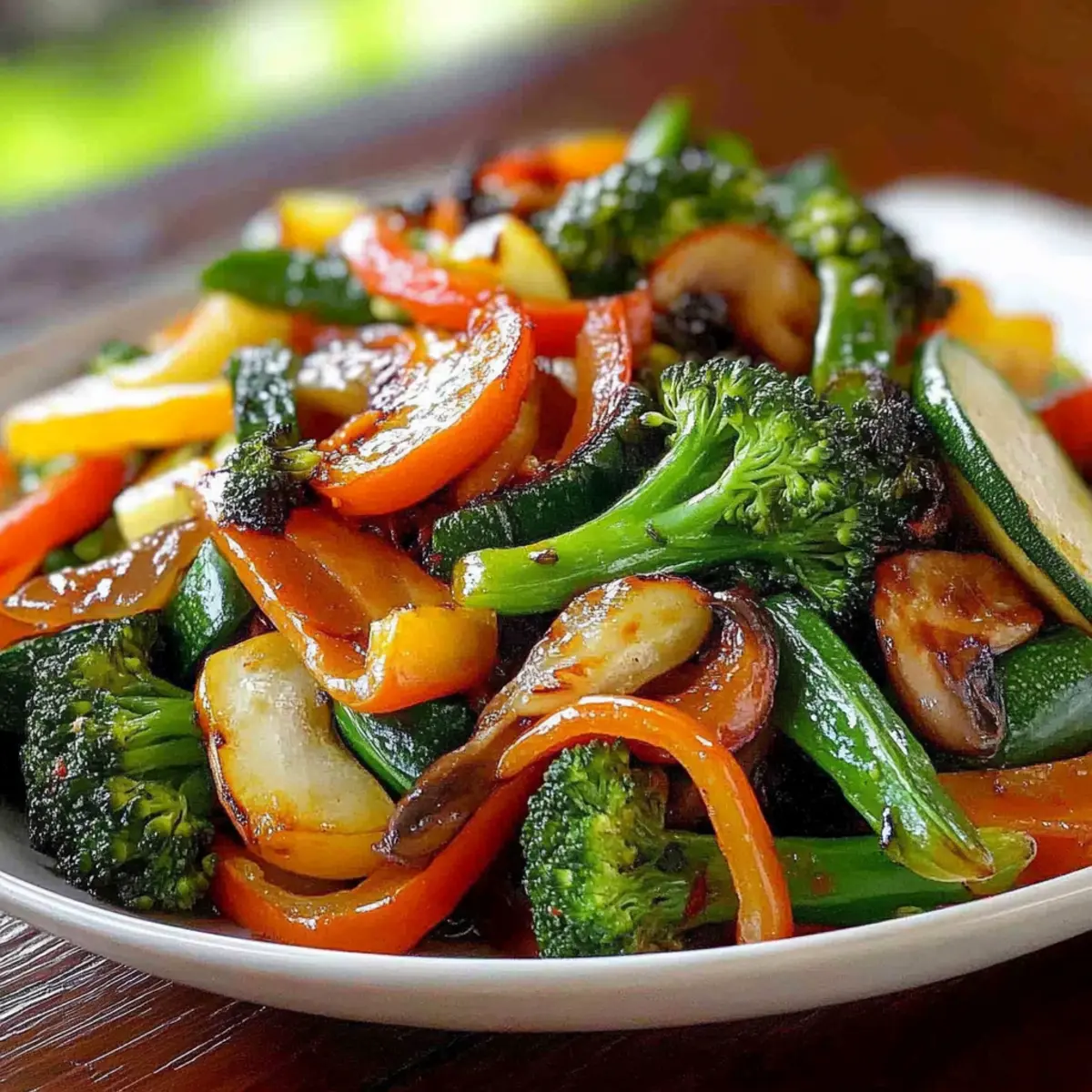As I tossed fresh vegetables into a sizzling skillet, the kitchen filled with the inviting aroma of garlic and sweet onions. It’s moments like this that remind me of the joy in preparing something both nourishing and colorful. Today, I’m excited to share my recipe for Healthy Sautéed Vegetables, a versatile dish that transforms ordinary meals into a vibrant feast. With just a hint of olive oil and the crunch of crisp-tender produce, this side dish not only makes weeknight dinners a breeze but also effortlessly supports your healthy lifestyle. Whether you’re looking for a quick veggie fix or a meal prep hero, these sautéed vegetables promise to bring both flavor and nutrition to your table. Curious about the toppings and variations you can explore? Let’s dive in!

Why Are Healthy Sautéed Vegetables So Great?
Quick and Easy: You can whip up this dish in under 30 minutes, making it perfect for busy weeknights. Nutrient-Packed: Every bite is loaded with fiber, vitamins, and antioxidants, supporting your healthy lifestyle. Versatile Flavors: Switch up ingredients and seasonings to match your cravings—think Asian-inspired, Mediterranean, or even spicy variations! Crowd-Pleaser: This dish complements any main course, from grilled chicken to tofu, ensuring everyone leaves the table happy. For more delicious ideas, check out my recipes for Light Healthy Broccoli or Healthy Carrot Cake.
Healthy Sautéed Vegetables Ingredients
For the Base
• 2 tbsp olive oil – Cooking medium that enhances flavor; substitute with avocado oil for a different taste profile.
• 2 cloves garlic, minced – Aromatic, adds depth of flavor; fresh garlic is preferred for the best results.
• 1 small onion, thinly sliced – Provides sweetness; can be substituted with shallots if desired.
For the Vegetables
• 1 bell pepper, sliced – Adds color and crunch; any color works, including red, yellow, or green.
• 1 zucchini, sliced into half-moons – Light and tender; can be swapped with yellow squash or omitted for dietary preferences.
• 1 cup broccoli florets – Nutritional powerhouse, offers crunch; substitute with cauliflower for a different texture.
• 1 medium carrot, julienned or sliced thin – Adds sweetness and vibrant color; swap with parsnip for a unique flavor.
• ½ cup snap peas – Crisp texture; can replace with green beans if unavailable.
• ½ cup mushrooms, sliced – Provides umami flavor; omit for a mushroom-free version.
Seasonings and Enhancements
• Salt and black pepper, to taste – Basic seasonings; experiment with flavored salts or other spices.
• 1 tsp lemon juice (optional) – Brightens flavors; lime juice or vinegar can be alternatives.
• 1 tsp balsamic vinegar or soy sauce (optional) – Adds depth; adjust based on taste preference.
• Optional toppings – Toasted nuts, seeds, fresh herbs, or grated Parmesan for added texture and richness.
Get your ingredients ready, and let’s make these Healthy Sautéed Vegetables the star of your next meal!
Step‑by‑Step Instructions for Healthy Sautéed Vegetables
Step 1: Prep Vegetables
Begin by washing and trimming your vegetables so they’re fresh and clean. Peel the carrot if needed and slice it thinly for even cooking. Cut the bell pepper into strips and the zucchini into half-moons, ensuring all pieces are roughly the same size to cook uniformly. Finally, mince the garlic and thinly slice the onion, setting everything aside for the next steps.
Step 2: Heat Pan
Place a large skillet over medium-high heat and add 2 tablespoons of olive oil. Allow the oil to heat for about 1-2 minutes, ensuring it shimmers but doesn’t smoke. This hot oil will create a perfect base for sautéing the vegetables, allowing them to caramelize and develop deeper flavors.
Step 3: Cook Aromatics
Once the oil is hot, add the minced garlic and sliced onions to the skillet. Sauté them for 1-2 minutes until the onions turn translucent and the garlic becomes fragrant—but be careful not to let it burn. This step infuses the oil with delicious aromatics, setting the perfect flavor foundation for your Healthy Sautéed Vegetables.
Step 4: Add Hard Vegetables
Next, add the julienned carrots and broccoli florets to the skillet. Continue cooking for about 3-4 minutes, stirring frequently. The goal is to soften these hearty vegetables while allowing them to retain some crunch. You’ll notice the vibrant colors intensifying, and they should be tender yet firm when done.
Step 5: Add Softer Vegetables
Now, gently fold in the bell peppers, zucchini, mushrooms, and snap peas into the mix. Sauté for another 4-5 minutes, stirring often, until everything is crisp-tender and bright. The vegetables should glisten and be vibrant in color, showcasing the fresh ingredients of your Healthy Sautéed Vegetables.
Step 6: Season
Once the vegetables are cooked to your liking, it’s time to season! Sprinkle salt, black pepper, and any optional flavor enhancers like lemon juice or balsamic vinegar. Toss everything together for even seasoning, and ensure the vegetables are coated well with the aromas, enhancing the overall flavor profile.
Step 7: Finish & Serve
Finally, remove the skillet from heat and give your sautéed vegetables one last toss. If desired, garnish with toasted nuts, fresh herbs, or a sprinkle of grated Parmesan for added richness. Serve immediately to enjoy the beautiful colors and delicious flavors of your Healthy Sautéed Vegetables, perfect as a side or mixed into your favorite main dish.

What to Serve with Healthy Sautéed Vegetables
Elevate your meal with complementary dishes that enhance the vibrant flavors and textures of your sautéed veggies.
- Grilled Chicken: Juicy, smoky chicken pairs beautifully with the crisp-tender veggies, creating a satisfying and balanced plate.
- Quinoa Salad: This nutty, protein-packed salad adds a wholesome base and enhances the dish’s nutritional value while offering a delightful chew.
- Toasted Garlic Bread: Crispy, buttery slices provide a comforting crunch, making every bite feel cozy and indulgent alongside your vegetables.
- Lemon Herb Couscous: Light and fluffy couscous, brightened with lemon zest, harmonizes with the freshness of sautéed vegetables for a delightful combination.
- Sparkling Water with Lime: A refreshing drink option that cleanses the palate, allowing the rich flavors of the vegetables to shine through.
- Chocolate Avocado Mousse: For dessert, this creamy, rich treat provides a velvety finish to your meal, contrasting with the crunch of the vegetables.
- Balsamic-Glazed Tofu: This savory option adds plant-based protein and a touch of sweetness, complementing the vegetables’ bright flavors.
These pairings will turn your dish of Healthy Sautéed Vegetables into a memorable meal everyone will love!
Expert Tips for Healthy Sautéed Vegetables
- Don’t Overcrowd the Pan: Cooking too many vegetables at once can lead to steaming instead of sautéing. Work in batches for optimal caramelization.
- Prep Ahead: Chop and prep vegetables ahead of time to streamline cooking on busy weeknights. This will make your Healthy Sautéed Vegetables a stress-free option.
- Adjust Cooking Times: Harder vegetables like carrots and broccoli need more time than softer ones like bell peppers and zucchini. Add them in stages for even cooking.
- Fresh Ingredients Matter: Always use fresh garlic and vegetables for the best flavor. Avoid pre-minced garlic, as it lacks the essential oils found in fresh cloves.
- Finish with Flair: Consider adding a splash of lemon juice or a drizzle of balsamic vinegar at the end for an extra layer of flavor that elevates your Healthy Sautéed Vegetables.
How to Store and Freeze Healthy Sautéed Vegetables
- Fridge: Store any leftover sautéed vegetables in an airtight container for up to 3–4 days. This keeps them fresh and ready for quick meals.
- Freezer: For longer storage, place the cooled sautéed vegetables in a freezer-safe bag, removing as much air as possible. They can be frozen for up to 3 months.
- Reheating: To reheat, thaw in the fridge overnight, then warm in a skillet with a splash of water for moisture preservation, ensuring your Healthy Sautéed Vegetables stay crisp and delicious.
Healthy Sautéed Vegetables Variations & Substitutions
Feel free to get creative with this recipe and make it your own in delightful ways! Let your taste buds guide you as you explore these delicious options.
-
Asian-Inspired: Add grated ginger, soy sauce, and a splash of sesame oil for a delicious twist. This flavor profile brings warming spices and comforting soy notes to your dish.
-
Spicy Kick: Toss in red pepper flakes or a dash of sriracha for a flavorful heat. The spice will awaken your taste buds, turning simple vegetables into something exciting.
-
Mediterranean: Switch to olive oil, and enhance with lemon zest and fresh herbs such as oregano or thyme for a refreshing touch. This makes a delightful pairing with grilled fish or chicken.
-
Herb-Forward: Try adding fresh basil, parsley, or dill to elevate the flavor and fragrance. This not only enhances taste but brings a vibrant green touch to your plate.
-
Nutty Variation: Sprinkle with toasted sesame seeds or chopped walnuts for added crunch and richness. The nuttiness wonderfully complements the crisp-tender veggies and offers a satisfying texture.
-
Creamy Finish: Stir in a dollop of ricotta or goat cheese before serving for a rich, creamy twist. This will add a luscious texture, balancing out the freshness of the vegetables beautifully.
Incorporate these variations in a big family meal, or mix and match them for meal prep. Play with flavors until you find the perfect combination—you can even pair this with my Healthy Sauteed Vegetables recipe for a delightful fusion of tastes!
Make Ahead Options
These Healthy Sautéed Vegetables are perfect for meal prep enthusiasts! You can wash, chop, and even sauté the vegetables up to 24 hours in advance, storing them in an airtight container in the refrigerator. For optimal flavor, prep individual components, like cutting the bell pepper, zucchini, and carrots, that can be kept fresh until it’s time to cook. When you’re ready to serve, simply reheat the sautéed mixture in a skillet with a splash of water to regain moisture and warmth. By prepping ahead, you’ll save valuable time on busy weeknights while still enjoying delicious, nutritious veggies that taste just as good as when freshly made!

Healthy Sautéed Vegetables Recipe FAQs
What’s the best way to select ripe vegetables for sautéing?
Absolutely! When choosing vegetables for your sauté, look for fresh, vibrant colors, and firm textures. For bell peppers, avoid ones with dark spots or wrinkles. Zucchinis should feel solid, and for broccoli, ensure the florets are tightly packed and bright green.
How should I store leftover sautéed vegetables?
Very simple! Place any leftover sautéed vegetables in an airtight container. They’ll stay fresh in the fridge for up to 3–4 days. Just reheat them quickly in a skillet with a splash of water to retain their moisture and crispness.
Can I freeze sautéed vegetables for later use?
Absolutely! To freeze, allow your sautéed vegetables to cool completely first. Then, transfer them to a freezer-safe bag, removing as much air as possible. They can be stored in the freezer for up to 3 months. When ready to use, simply thaw in the fridge overnight and reheat as directed.
What should I do if my vegetables are soggy after sautéing?
Don’t worry! This can happen if you overcrowd the pan or use too little heat. For the best results, cook in batches and ensure your pan is hot enough before adding your ingredients. If they do turn soggy, try to stir-fry over higher heat briefly to help them crisp up again.
Are there any dietary considerations I should keep in mind?
Very much so! This recipe is inherently vegan and vegetarian-friendly. If cooking for pets, remember that some vegetables may not be safe for them—always consult with your vet. Additionally, if allergies are a concern, watch for common allergens like mushrooms or certain spices.
Can I modify the recipe to suit specific dietary needs?
Absolutely! The beauty of healthy sautéed vegetables lies in their versatility. You can easily substitute any veggie to fit your preferences or dietary requirements. For instance, if you’re low on one type of vegetable, feel free to add more of another, and experiment with herbs and spices for added flavor!

Delicious Healthy Sautéed Vegetables for Quick Weeknight Dinners
Ingredients
Equipment
Method
- Begin by washing and trimming your vegetables so they’re fresh and clean. Peel the carrot if needed and slice it thinly for even cooking. Cut the bell pepper into strips and the zucchini into half-moons, ensuring all pieces are roughly the same size to cook uniformly. Finally, mince the garlic and thinly slice the onion, setting everything aside for the next steps.
- Place a large skillet over medium-high heat and add 2 tablespoons of olive oil. Allow the oil to heat for about 1-2 minutes, ensuring it shimmers but doesn't smoke. This hot oil will create a perfect base for sautéing the vegetables, allowing them to caramelize and develop deeper flavors.
- Once the oil is hot, add the minced garlic and sliced onions to the skillet. Sauté them for 1-2 minutes until the onions turn translucent and the garlic becomes fragrant—but be careful not to let it burn.
- Next, add the julienned carrots and broccoli florets to the skillet. Continue cooking for about 3-4 minutes, stirring frequently. The goal is to soften these hearty vegetables while allowing them to retain some crunch.
- Now, gently fold in the bell peppers, zucchini, mushrooms, and snap peas into the mix. Sauté for another 4-5 minutes, stirring often, until everything is crisp-tender and bright.
- Once the vegetables are cooked to your liking, it’s time to season! Sprinkle salt, black pepper, and any optional flavor enhancers like lemon juice or balsamic vinegar. Toss everything together for even seasoning.
- Finally, remove the skillet from heat and give your sautéed vegetables one last toss. If desired, garnish with toasted nuts, fresh herbs, or a sprinkle of grated Parmesan for added richness. Serve immediately.

Leave a Reply